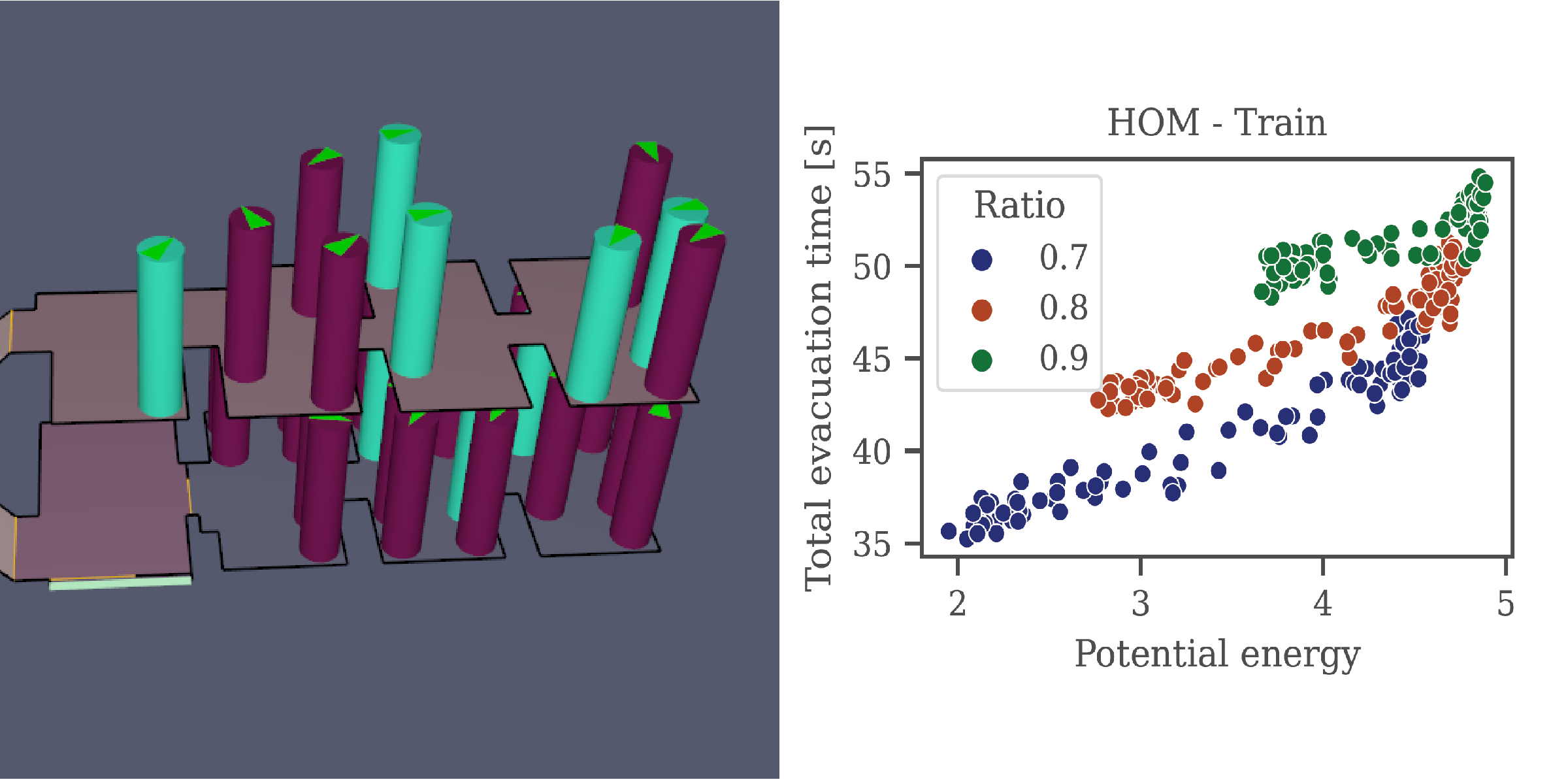Evacuation from Cramped Interiors with Aisle Seats: Uncertainty Induced by the Random Choice of Initial Positions
DOI:
https://doi.org/10.17815/CD.2024.183Keywords:
Uncertainity analysis, Evacuation, Simulation, Agent heterogeneity, Initial seating positions, Energy based descriptionAbstract
Considering evacuation from cramped interiors with aisle seats, the initial seating positions of pedestrians represent a non-negligible source of variance in total evacuation time. By means of Pathfinder simulations, this uncertainty is quantitatively investigated for a train and lecture hall geometry with homogeneous and heterogeneous groups of agents. Furthermore, an energy-inspired description of the occupation configuration is introduced that enables a proper numerical representation of the configuration space of the initial seating positions.
References
Delcea, C., Cotfas, L.A., Craciun, L., Molanescu, A.G.: Establishing the Proper Seating Arrangement in Elevated Lecture Halls for a Faster Evacuation Process. IEEE Access 7, 48500-48513 (2019). doi:10.1109/ACCESS.2019.2909637. URL https://ieeexplore.ieee.org/document/8682047/
Najmanová, H., Kuklík, L., Pešková, V., Bukáček, M., Hrabák, P., Vašata, D.: Evacuation trials from a double-deck electric train unit: Experimental data and sensitivity analysis. Safety Science 146, 105523 (2022). doi:https://doi.org/10.1016/j.ssci.2021.105523. URL https://www.sciencedirect.com/science/article/pii/S0925753521003660
Gobbin, A., Khosravi, R., Bardenhagen, A.: Emergency evacuation simulation of commercial aircraft. SN Applied Sciences 3(446) (2021). doi:10.1007/s42452-021-04295-z. URL https://link.springer.com/article/10.1007/s42452-021-04295-z
Larsson, A., Ranudd, E., Ronchi, E., Hunt, A., Gwynne, S.: The impact of crowd composition on egress performance. Fire Safety Journal 120, 103040 (2021). doi:10.1016/j.firesaf.2020.103040. URL https://www.sciencedirect.com/science/article/pii/S0379711220300448
Tong, Y., Bode, N.W.: Simulation investigation on crowd evacuation strategies for helping vulnerable pedestrians at different stages of egress. International Journal of Disaster Risk Reduction 84, 103479 (2023). doi:10.1016/j.ijdrr.2022.103479. URL https://linkinghub.elsevier.com/retrieve/pii/S2212420922006987
Geoerg, P., Schumann, J., Boltes, M., Kinateder, M.: How people with disabilities influence crowd dynamics of pedestrian movement through bottlenecks. Sci Rep 12(1), 14273 (2022). doi:10.1038/s41598-022-18142-7. URL https://www.nature.com/articles/s41598-022-18142-7. Number: 1 Publisher: Nature Publishing Group
Campanella, M., Hoogendoorn, S.P., Daamen, W.: Effects of Heterogeneity on Self-Organized Pedestrian Flows. Transportation Research Record 2124(1), 148-156 (2009). doi:10.3141/2124-14. URL https://doi.org/10.3141/2124-14. Publisher: SAGE Publications Inc
Rangel-Huerta, A., Ballinas-Hernández, A.L., Muñoz-Meléndez, A.: An entropy model to measure heterogeneity of pedestrian crowds using self-propelled agents. Physica A: Statistical Mechanics and its Applications 473, 213-224 (2017). doi:10.1016/j.physa.2016.12.090. URL https://www.sciencedirect.com/science/article/pii/S0378437116310779
Zheng, X., Cheng, Y.: Modeling cooperative and competitive behaviors in emergency evacuation: A game-theoretical approach. Computers & Mathematics with Applications 62(12), 4627-4634 (2011). doi:10.1016/j.camwa.2011.10.048. URL https://www.sciencedirect.com/science/article/pii/S0898122111009126
Haghani, M., Sarvi, M., Shahhoseini, Z., Boltes, M.: Dynamics of social groups’ decision-making in evacuations. Transportation Research Part C: Emerging Technologies 104, 135-157 (2019). doi:10.1016/j.trc.2019.04.029. URL https://www.sciencedirect.com/science/article/pii/S0968090X18307009
Ren, J., Mao, Z., Zhang, D., Gong, M., Zuo, S.: Experimental study of crowd evacuation dynamics considering small group behavioral patterns. International Journal of Disaster Risk Reduction 80, 103228 (2022). doi:10.1016/j.ijdrr.2022.103228. URL https://www.sciencedirect.com/science/article/pii/S2212420922004472
Koppel, S., Octavio, J.J., Bohman, K., Logan, D., Raphael, W., Jimenez, L.Q., Lopez-Valdes, F.: Seating configuration and position preferences in fully automated vehicles. Traffic Injury Prevention 20(sup2), S103-S109 (2019). doi:10.1080/15389588.2019.1625336. URL https://doi.org/10.1080/15389588.2019.1625336. PMID: 31246512
Nie, B., Gan, S., Chen, W., Zhou, Q.: Seating preferences in highly automated vehicles and occupant safety awareness: A national survey of chinese perceptions. Traffic Injury Prevention 21(4), 247-253 (2020). doi:10.1080/15389588.2020.1738013. URL https://doi.org/10.1080/15389588.2020.1738013. PMID: 32275164
Hrabák, P., Kmec, J., Najmanová, H., Vašata, D.: Challenges in train evacuation modelling using pathfinder. In: Proceedings of the 6th Fire and Evacuation Modeling Technical Conference. Thunderhead Engineering (2022)
Saltelli, A.: Global sensitivity analysis: the primer. John Wiley (2008)
Gödel, M., Fischer, R., Köster, G.: Sensitivity analysis for microscopic crowd simulation. Algorithms 13(7) (2020). doi:10.3390/a13070162. URL https://www.mdpi.com/1999-4893/13/7/162
Helbing, D., Molnár, P.: Social force model for pedestrian dynamics. Phys. Rev. E 51, 4282-4286 (1995). doi:10.1103/PhysRevE.51.4282. URL https://link.aps.org/doi/10.1103/PhysRevE.51.4282
Helbing, D., Buzna, L., Johansson, A., Werner, T.: Self-organized pedestrian crowd dynamics: Experiments, simulations, and design solutions. Transportation Science 39, 1-24 (2005). doi:10.1287/trsc.1040.0108. URL https://pubsonline.informs.org/doi/10.1287/trsc.1040.0108
Pathfinder technical reference manual (2022). URL https://support.thunderheadeng.com/docs/pathfinder/2022-3/technical-reference-manual/
Kmec, J.: Sensitivity analysis of models of cramped interior evacuation. Master's thesis, Czech Technical University in Prague, Prague, Czechia (2023). Available at https://dspace.cvut.cz/handle/10467/108820

Downloads
Published
How to Cite
Issue
Section
Categories
License
Copyright (c) 2024 Pavel Hrabák, Juraj Kmec, Hana Najmanová, Daniel Vašata

This work is licensed under a Creative Commons Attribution 4.0 International License.
Authors contributing to Collective Dynamics agree to publish their articles under the Creative Commons Attribution 4.0 license.
This license allows:
Share — copy and redistribute the material in any medium or format
Adapt — remix, transform, and build upon the material
for any purpose, even commercially.
The licensor cannot revoke these freedoms as long as you follow the license terms.
Authors retain copyright of their work. They are permitted and encouraged to post items submitted to Collective Dynamics on personal or institutional websites and repositories, prior to and after publication (while providing the bibliographic details of that publication).








